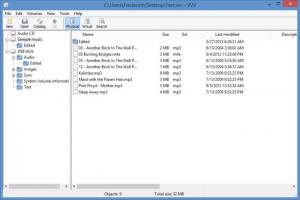
VVV (Virtual Volumes View)
1.2
Size: 0 Bytes
Downloads: 4239
Platform: Windows (All Versions)
If you store important data on multiple CDs or other removable drives, you may find it difficult to locate specific files. If you don't want to insert each CD in your computer, one after another, then you should try VVV (which is short for Virtual Volumes View). The application can be used to catalog any data on CDs, USB sticks, on a removable hard drive and other storage devices. As a result, you will be able to browse through the contents of these devices, without connecting or inserting them.
VVV is open source and it is distributed under the GNU General Public License, which means that you don't have to pay for it. The application works on Windows, Linux and Mac OS X platforms and it can be installed in a few seconds, without any effort. Its hardware requirements are modest and you don't have to install any additional tools or services.
The user interface is laid out like a standard explorer window, but it is blank when you start a new project. To catalog one or more devices, you have to add them to a list, on a small window, using a standard browsing dialog. When cataloging devices, the application will take a snapshot of its entire files and folders structure and save it on its user interface. Cataloged devices are displayed in a tree structure, on the left side of the main interface, along with their folders and sub-folders and you can explore their contained files in the larger area on the right.
Once you catalog your CDs or other devices, you can browse through their data without inserting them into your computer, which is more comfortable and efficient than inserting each CD and looking through its files. Besides removable drives, the application allows you to catalog local folders as well. The procedure is the same and the folders will appear in the same tree structure.
If you wish to categorize your cataloged devices, you may create virtual folders, in a different section of the interface. All you have to do is right click a device and select an option and choose one of your virtual folders. Regardless if you categorize your devices or not, you can use a search function to locate specific files instantly. The application allows you to set up various parameters, like searching in physical or virtual folders, matching keywords to entire file names or part of them and more.
Pros
Removable drives and local folders can be cataloged instantly, without any effort. The application allows you to organize your cataloged data in virtual folders. Also, you can use a search function to locate the files you need much faster.
Cons
There are no obvious drawbacks to mention. With VVV (Virtual Volumes View), you can find any files from any device instantly, without any effort.
VVV (Virtual Volumes View)
1.2
Download
VVV (Virtual Volumes View) Awards
_award.png)
VVV (Virtual Volumes View) Editor’s Review Rating
VVV (Virtual Volumes View) has been reviewed by Frederick Barton on 21 Mar 2014. Based on the user interface, features and complexity, Findmysoft has rated VVV (Virtual Volumes View) 5 out of 5 stars, naming it Essential
























